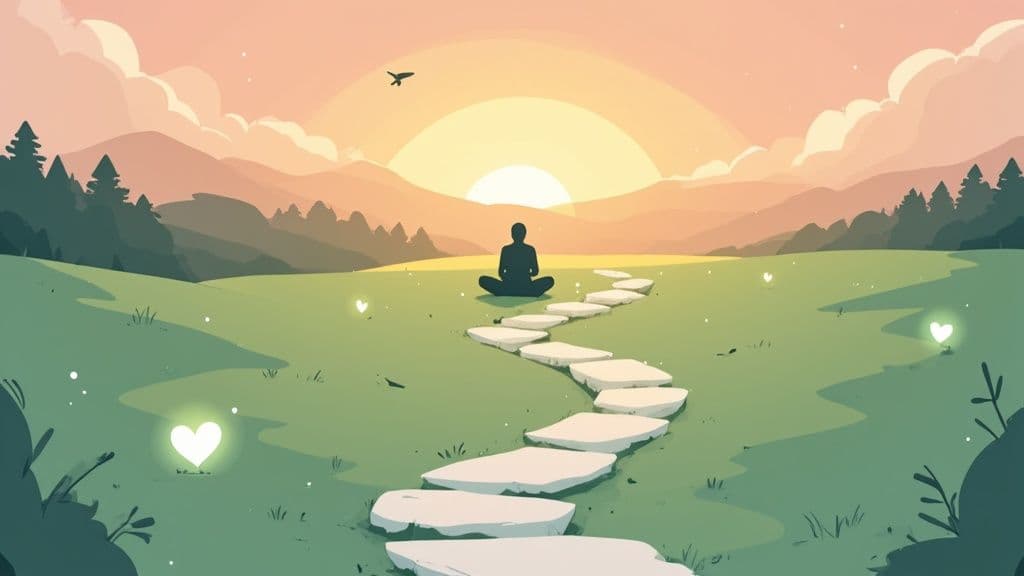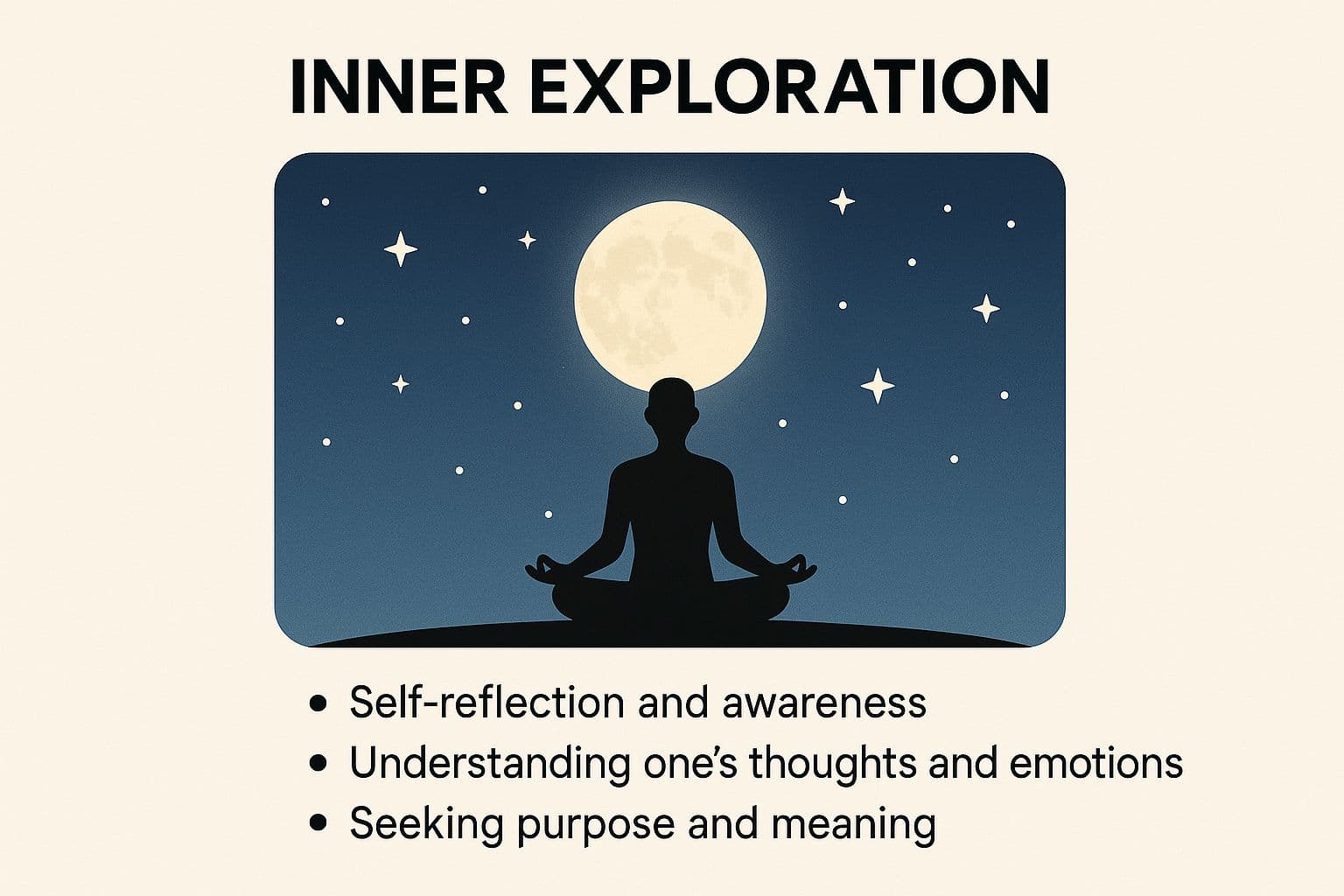Embarking on a spiritual journey starts with a small, intentional choice to get curious and create space to listen. This guide offers clear, practical steps—set an intention, declutter your life, and build tiny daily practices—so you can find more meaning, calm, and alignment.
July 13, 2025 (5mo ago) — last updated December 6, 2025 (10d ago)
How to Start a Spiritual Journey: Practical Steps
Simple, practical steps to begin a spiritual journey: set intentions, build small daily practices, declutter life, and find calm and purpose.
← Back to blog
How to Start a Spiritual Journey: Practical Guide
Learn practical steps to begin a spiritual journey and find more meaning, calm, and purpose in everyday life.
Introduction
Embarking on a spiritual journey starts with a single choice: to get curious and create space to listen. This guide gives clear, practical steps—set an intention, simplify your life, and build small daily practices—so you can feel calmer, clearer, and more aligned with what matters most.
What a Spiritual Journey Really Means Today
When you hear “spiritual journey,” you might picture monasteries or strict doctrine. Today, it’s usually more personal and within reach. At its core, a spiritual journey is a decision to look past the surface—the job, the to-do lists—and ask, “What truly matters?” It’s a practical path toward meaning, purpose, and a deeper connection to yourself and the world.
This isn’t necessarily about adopting a religion. Think of it like tending an inner garden: you can’t force a flower to bloom, but you can create conditions for growth. A spiritual journey is about cultivating practices that quiet mental noise so self-awareness can flourish.
The Foundation of Self-Discovery
A spiritual journey is an act of self-discovery—an invitation to examine your beliefs, values, and the essence of who you are. It’s not about finding one universal answer but about uncovering your truth.
Key ingredients include:
- Self-reflection: Carve time to sit with your thoughts, feelings, and actions without judgment.
- Mindfulness: Practice being present so you can step back from the mind’s chatter.
- Connection: Develop a relationship with something larger—nature, humanity, the cosmos, or a higher power.
- Alignment: Make choices that feel authentic and true to your values.

Core Components of a Modern Spiritual Journey
| Component | What It Involves | First Step Example |
|---|---|---|
| Introspection & Journaling | Regularly writing to gain clarity and track growth. | Buy a notebook and write for 5 minutes before bed about one thing that made you feel truly alive today. |
| Mindfulness & Meditation | Practices that anchor you in the present and reduce stress. | Try a 2-minute guided breathing exercise using an app or a YouTube video. |
| Connection to Nature | Intentional time outdoors to feel part of something larger. | Go for a walk without your phone and notice the sounds, sights, and smells. |
| Seeking Knowledge | Explore philosophies or spiritual texts to broaden perspective. | Read a chapter on stoicism or mindfulness. |
| Living with Purpose | Align daily actions with your deepest values. | Identify one core value (e.g., kindness) and express it tomorrow. |
These components aren’t a checklist to finish but tools to explore and integrate into life in ways that feel right for you.
Laying the Groundwork for Your Spiritual Path
Before diving in, prepare both your headspace and your home. Think of it as pulling weeds before planting seeds. Ask yourself: What am I genuinely hoping to find? Your answer becomes a compass when things feel confusing.
The global market for spiritual services reflects a growing search for meaning—projected to reach $392.46 billion by 20251. Spiritual travel and related offerings are also rising as people seek immersive experiences that open the door to new practices4.
Set a Clear and Sincere Intention
Your intention is the emotional heartbeat of your journey. It doesn’t need to be grand—simple and honest works best. Maybe you want inner peace, healing, or clarity. Write it down; putting it on paper makes it tangible.
Examples:
- A burned-out lawyer might set: “I want to quiet my racing mind and be present.”
- Someone grieving might set: “I want to find meaning and hope in what I’ve been through.”
An intention isn’t a goal to achieve; it’s a quality of awareness you bring into life.
Declutter Your Mental and Physical Space
Our minds often mirror a cluttered desk—notifications, social media, and inner critics. To hear your intuition, lower the volume on outside noise.
Start with your digital world: turn off nonessential notifications, unsubscribe from junk email, and set specific times for social media.
Then tend your physical space. A tidy corner can calm your mind.
Practical ideas:
- Create a sacred corner: A cushion by a window, a plant, or a clean table corner for a candle and journal.
- The 5-minute tidy: Spend five minutes each evening putting things away in one room.
- Digital sunset: Put your phone away at least 30 minutes before bed.
Clearing noise—mental and physical—creates a welcoming foundation for deeper work.
Practical First Steps to Begin Your Exploration
You’ve set your intention and cleared space. Now begin exploration with small, consistent actions. Start small—consistency beats intensity.
Introduce Moments of Quiet Reflection
Silence is rare and precious. Try a five-minute daily meditation: sit comfortably, close your eyes, and focus on the breath. When the mind wanders, gently return to the breath without judgment. Meditation programs have been shown to reduce symptoms of anxiety and depression in some studies, and even short consistent practice can help build resilience3.
Try a gratitude practice before sleep: jot down three specific things you’re grateful for and why. This trains your brain to notice positives.
Connect with the World Around You
Spirituality is both internal and relational. A mindful walk can be a moving meditation—leave your phone at home and notice the details you usually miss. Time in nature has measurable benefits for mood and can reduce repetitive negative thinking, making it a practical practice for many people2.
Traveling can also trigger deep inner change; spiritual tourism and immersive retreats are growing as ways people explore new practices and contexts4.
Find Community
You don’t have to walk this path alone. Community offers support and shared experience.
Ways to connect:
- Join a local yoga or tai chi class.
- Find a meditation group at a community center.
- Explore online forums focused on spiritual growth.
A supportive group helps you feel seen and reminds you you’re part of a larger web of seekers.
Tools and Resources to Go Deeper on Your Path
As momentum builds, you may want tools that resonate with you. Blend timeless wisdom with modern resources to build a practice that fits your life.
Reading teachers like Thich Nhat Hanh or Eckhart Tolle can offer gentle and profound entry points. Podcasts, guided meditation apps, and journaling tools make practice accessible.
The Life Purpose App offers personalized insights that can clarify your strengths and life themes. It’s one example of how digital tools can support deeper self-understanding. Explore related guides on growing spiritually and increasing self-awareness here: How to Grow Spiritually and How to Be More Self-Aware.
Useful tools:
- Guided meditation apps for structure and habit-building.
- Journaling apps to track thoughts and emotional patterns.
- Purpose-finding platforms for personalized insights.
- Insightful podcasts for thoughtful perspectives on the go.
Faith-based tourism and digital guides are expanding access to spiritual sites and experiences, and that market is growing rapidly5.
Navigating Challenges and Staying Consistent
This path won’t always be a straight line. You’ll have clarity and also doubt. Challenges are part of the process, not signs of failure. The key is resilience and compassion for yourself.
When Motivation Fades
If your practice feels like a chore, adapt instead of giving up. Try micro-practices: one minute of deep breathing in your car or 30 seconds feeling your feet on the floor. Reconnect with your original intention to refuel your motivation.
Dealing with Skepticism
Skepticism may come from others or from inside. You don’t owe anyone an explanation. When doubt appears, gather your own evidence: note moments of peace or insights in your journal.
When You Don’t See Immediate Results
Spiritual growth is gradual—more like growing a tree than building furniture. Celebrate effort, notice small shifts (a pause before reacting, more awareness, or added self-compassion), and focus on process over instant results.
FAQs
How is spirituality different from religion?
Religion is an organized system with shared texts, rituals, and community structure. Spirituality is a personal search for meaning and connection. They can overlap, but they aren’t the same.
Do I need to believe in God to be spiritual?
No. Spiritual connection can be found in nature, relationships, awe of the cosmos, or deeper self-awareness. Belief in a deity is optional and personal.
How much time should I commit each day?
Consistency matters more than duration. Start with just five minutes a day and scale up if it feels right. Small daily practices build lasting change.
Quick Q&A: Common Beginner Questions
Q: What’s one simple thing I can start today? A: Try a two-minute breathing practice or write one line in a gratitude journal tonight.
Q: What if I miss days? A: That’s normal. Return with compassion and a tiny practice to rebuild momentum.
Q: How do I find what’s right for me? A: Sample different practices—meditation, walking, journaling—and notice which bring calm, clarity, or presence.
Practical Q&A — Three Concise Answers for New Starters
Q: What is the easiest daily habit that makes the biggest difference?
A: A one- to five-minute breathing or gratitude practice each day. Small, consistent habits change attention and reduce reactivity.
Q: How do I stay motivated when life gets busy?
A: Scale practices to fit your day: micro-practices (30–60 seconds) and reconnecting to your written intention help maintain momentum.
Q: Where should I look for trustworthy guidance?
A: Start with established teachers, peer-reviewed studies, and reputable apps or community groups. Track what actually helps you and prioritize practices that produce calm and clarity.
Discover Your Life Purpose Today!
Unlock your true potential and find your life’s purpose.
